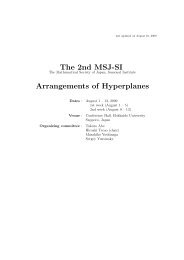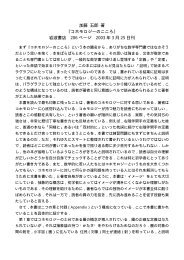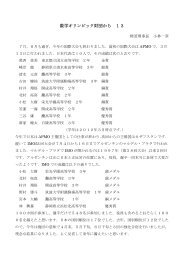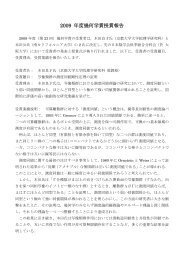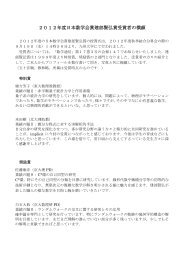Titles and Short Summaries of the Talks
Titles and Short Summaries of the Talks
Titles and Short Summaries of the Talks
You also want an ePaper? Increase the reach of your titles
YUMPU automatically turns print PDFs into web optimized ePapers that Google loves.
39 Functional Equations<br />
Final: 2013/2/7<br />
5 Katsuyuki Nishimoto<br />
∗ Solutions to <strong>the</strong> homogeneous Bessel equation by means <strong>of</strong> N-fractional<br />
(Descartes Press Co.) calculus operator · · · · · · · · · · · · · · · · · · · · · · · · · · · · · · · · · · · · · · · · · · · · · · · 15<br />
Summary: In this article, <strong>the</strong> solutions to <strong>the</strong> homogeneous Bessel equation are discussed by<br />
means <strong>of</strong> <strong>the</strong> N-fractional calculus operator (NFCO). That is, we have <strong>the</strong> particular solutions as<br />
follows, for example.<br />
φ [1] = z ν e iz (e −i2z · z −(ν+1/2) ) ν−1/2 (fractional differintegrated form)<br />
= (−i2) ν−1/2z −1/2e−iz 2F0( 1<br />
<br />
2<br />
<br />
( i<br />
<br />
<br />
< 1)<br />
2z<br />
= A · H (2)<br />
ν (z), (A = √ π2 ν−1 e −iπν )<br />
<strong>and</strong><br />
1 i<br />
− ν, 2 + ν; 2z )<br />
φ [6] = z −ν e iz (z ν−1/2 · e −i2z ) −(ν+1/2) (fractional differintegrated form)<br />
= eiπ(ν+1/2) Γ(−2ν)zν e−iz 1F1( 1<br />
( )<br />
2 + ν; 1 + 2ν; 2iz) (|2iz| < 1)<br />
Γ(−2ν−k) <br />
< ∞<br />
Γ(−ν+1/2)<br />
= B ∗ · J (2)<br />
ν (z), (B ∗ = 2 ν Γ(−2ν)Γ(1 + ν)e iπ(ν+1/2) )<br />
where pFq(· · · · · · ) is <strong>the</strong> generalized Gauss hypergeometric function, H (2)<br />
ν (z) is <strong>the</strong> Hankel function,<br />
<strong>and</strong><br />
J (2)<br />
ν (z) = e−iz (z/2) ν<br />
1<br />
Γ(1+ν) 1F1( 2 + ν; 1 + 2ν; 2iz) = Jν(z) (|2iz| < 1)<br />
is <strong>the</strong> first kind Bessel Function.<br />
6 Katsuyuki Nishimoto<br />
∗ The solutions to <strong>the</strong> radial Schrödinger equation <strong>of</strong> <strong>the</strong> hydrogen atom<br />
(Descartes Press Co.) by means <strong>of</strong> N-fractional calculus operator · · · · · · · · · · · · · · · · · · · · · · · · 15<br />
Summary: In this article, <strong>the</strong> solutions to <strong>the</strong> radial Schrödinger equation <strong>of</strong> <strong>the</strong> Hydrogen atom<br />
(in <strong>the</strong> Coulomb field)<br />
φ2 · x 2 + φ1 · 2x + φ · {−(1/4)x 2 + νx + l(l + 1)} = 0<br />
are discussed by means <strong>of</strong> N-fractional calculus operator.<br />
A particular solution to <strong>the</strong> equation above is shown as follows for example.<br />
φ = φ [1] = x l e x/2 (e −x · x ν−(l+1) )l+ν (fractional differintegrated form)<br />
= (e iπ ) l+ν e −x/2 x ν−1 2F0(−l − ν, l + 1 − ν; −1/x)<br />
(| − 1/x| < 1)<br />
where pFq(· · · · · · ); Generalized Gauss hypergeometric functions.<br />
7 Ryu Sasaki (Kyoto Univ.) ♯ Global solutions <strong>of</strong> certain second order differential equations with a<br />
Kouichi Takemura (Chuo Univ.) high degree <strong>of</strong> apparent singularity · · · · · · · · · · · · · · · · · · · · · · · · · · · · · · · 10<br />
Summary: Infinitely many explicit solutions <strong>of</strong> certain second order differential equations with an<br />
apparent singularity <strong>of</strong> characteristic exponent −2 are constructed by adjusting <strong>the</strong> parameter <strong>of</strong><br />
<strong>the</strong> multi-indexed Laguerre polynomials.<br />
8 Nobuki Takayama<br />
(Kobe Univ./JST CREST)<br />
♯ Pfaffian systems <strong>of</strong> A-hypergeometric sysytems · · · · · · · · · · · · · · · · · · · · 15<br />
Takayuki Hibi<br />
(Osaka Univ./JST CREST)<br />
Kenta Nishiyama<br />
(Osaka Univ./JST CREST)<br />
Summary: We are interested in bases <strong>of</strong> Rn/(RnHA[s]) as <strong>the</strong> vector space over <strong>the</strong> field C(s, x)<br />
where HA[s] is an A-hypergeometric ideal. Any basis <strong>of</strong> <strong>the</strong> vector space yields an associated<br />
Pfaffian system or an integrable connection associated to HA[s]. Bases can be described by those<br />
<strong>of</strong> simpler quotients Rn/(inw(IA) + ∑ Rn(Ei − si)).




